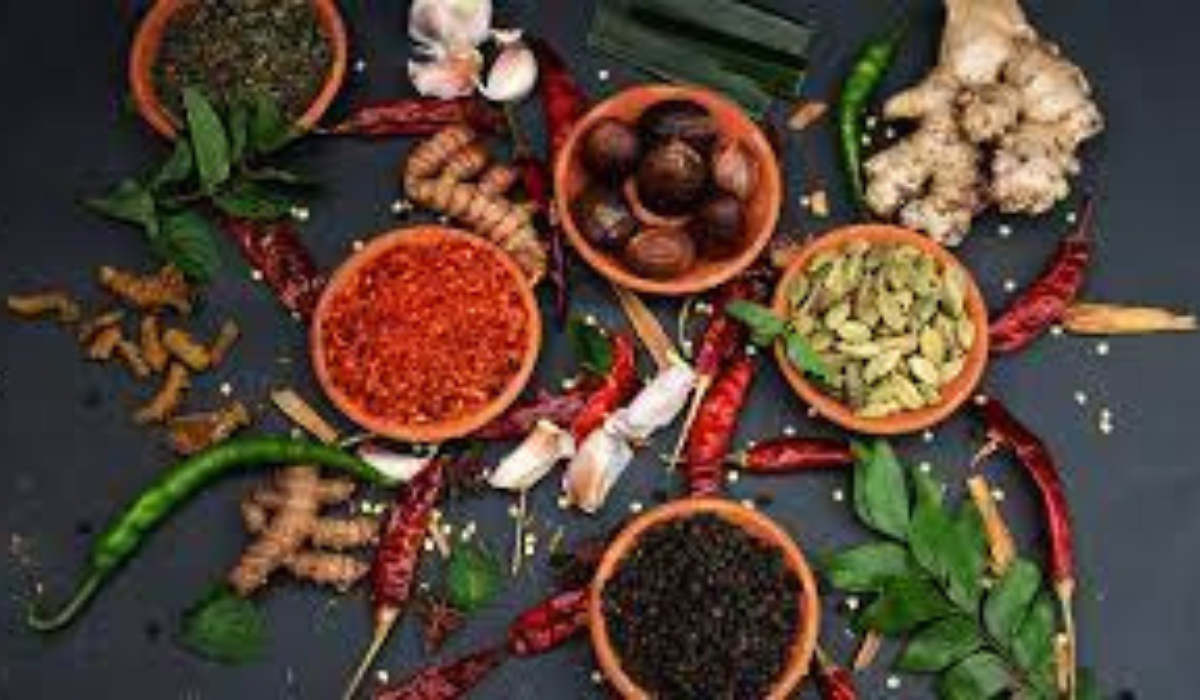I. Introduction to Spices in Sri Lanka
Table of Contents
A. Historical Significance of Spices of Sri lanka
Sri Lanka, historically known as Ceylon, has been a hub of spice trade for centuries. The island’s strategic location in the Indian Ocean made it a crucial stopover for ancient traders, who sought out its coveted spices like cinnamon, pepper, and cardamom. The cultural influences brought by spice trading have left an indelible mark on Sri Lankan cuisine and traditions, making spices an integral part of the nation’s heritage and agricultural industry of Sri Lanka.
B. Geographical Impact on Spice Production





Sri Lanka’s diverse ecosystems, ranging from tropical rainforests to misty highlands, provide ideal conditions for cultivating a wide variety of spices. The island’s unique soil types and microclimates contribute to the distinct flavors and aromas of its spices, which are highly sought after in global markets.
C. Importance in Sri Lankan Cuisine
Spices are the foundation of Sri Lankan cuisine, adding depth, complexity, and a signature taste to traditional dishes. From the fiery curries of the south to the aromatic rice preparations of the north, spices are used liberally in Sri Lankan cooking. The fusion of spices in contemporary Sri Lankan cuisine has also led to innovative and delectable creations.
II. Major Spices Cultivated in Sri Lanka
A. Cinnamon – The King of Spices
Ceylon cinnamon, known as “true cinnamon,” is one of Sri Lanka’s most famous exports. The cinnamon tree, native to Sri Lanka, produces a spice that is prized for its delicate flavor and sweet aroma. The cultivation of cinnamon is an art passed down through generations, involving meticulous methods of peeling and drying the inner bark of the tree. This labor-intensive process results in a spice that is lighter, more aromatic, and less pungent than cassia cinnamon, commonly found in other parts of the world. Cinnamon’s economic significance is immense, as it remains a major contributor to Sri Lanka’s export economy.
B. Pepper – The Black Gold
Ceylon cinnamon, known as “true cinnamon,” is one of Sri Lanka’s most famous exports. The cinnamon tree, native to Sri Lanka, produces a spice that is prized for its delicate flavor and sweet aroma. The cultivation of cinnamon is an art passed down through generations, involving meticulous methods of peeling and drying the inner bark of the tree. This labor-intensive process results in a spice that is lighter, more aromatic, and less pungent than cassia cinnamon, commonly found in other parts of the world. Cinnamon’s economic significance is immense, as it remains a major contributor to Sri Lanka’s export economy.
C. Cardamom – The Queen of Spices
Cardamom, the “queen of spices,” is another gem in Sri Lanka’s spice crown. This aromatic spice is cultivated in the central highlands, where the cool climate and shaded forests provide the perfect conditions for its growth. Cardamom is known for its sweet, floral flavor and is a key ingredient in both sweet and savory dishes. In Sri Lanka, cardamom is not only used in traditional cooking but also in Ayurvedic medicine, where it is valued for its digestive and medicinal properties. The spice’s delicate flavor and health benefits make it a prized commodity in both local and international markets.
III. Traditional Spice Farming Practices
A. Organic Farming Techniques
Many Sri Lankan spice farmers have embraced organic cultivation methods, recognizing the importance of sustainable practices for both the environment and consumer health. These techniques involve the use of natural fertilizers, pest control methods, and water conservation strategies, ensuring that the spices produced are free from harmful chemicals and preservatives.
B. Community-Based Farming Initiatives





Spice cultivation in Sri Lanka often involves cooperative farming efforts, where small-scale farmers work together to share resources, knowledge, and best practices. These community-based initiatives promote sustainable farming methods, fair trade practices, and the preservation of traditional knowledge.
C. Challenges Faced by Spice Farmers
Sri Lankan spice farmers face various challenges, including climate change, pest infestations, and market volatility. Erratic weather patterns and extreme weather events can significantly impact crop yields, while pests and diseases can threaten the health of spice plants. Additionally, fluctuating prices in the global spice market can make it difficult for farmers to maintain a stable income.
IV. The Role of Spices in Sri Lankan Culture and Traditions
A. Spices in Ayurveda and Traditional Medicine
Ayurveda, Sri Lanka’s traditional system of medicine, extensively utilizes spices for their medicinal properties. Spices like cinnamon, cardamom, and turmeric are believed to have therapeutic effects, ranging from improving digestion to boosting the immune system. The integration of spices in modern health trends, such as herbal teas and dietary supplements, has further popularized their health benefits.
B. Spices in Local Festivals and Ceremonies
Spices play a significant role in Sri Lankan festivals and ceremonies, particularly in the preparation of traditional dishes. During the Sinhala and Tamil New Year celebrations, for example, families gather to make elaborate rice preparations flavored with cinnamon, cardamom, and cloves. Spices are also used in various rituals and ceremonies, such as weddings and religious observances, symbolizing purity, prosperity, and good fortune.
C. Artisanal and Craft Products from Spices
Sri Lanka’s spice heritage has inspired the creation of a wide range of artisanal and craft products. From essential oils and fragrances to soaps and candles, spices are used as the primary ingredients in many locally produced goods. These products not only showcase the versatility of spices but also contribute to the island’s thriving tourism industry, as visitors seek out unique souvenirs and gifts.
V. Future of Spice Cultivation and Trade in Sri Lanka
A. Innovations in Spice Agriculture
Sri Lankan spice farmers are embracing technological advancements to improve crop yields and processing efficiency. The use of precision farming techniques, such as GPS-guided tractors and drones for crop monitoring, has helped optimize resource allocation and reduce waste. Research and development in spice varieties have also led to the creation of new cultivars with improved disease resistance and higher yields.
B. Global Trends Influencing Sri Lankan Spice Markets
As consumer preferences shift towards healthier and more sustainable food options, the demand for organic and ethically sourced spices has increased. Sri Lankan spice producers are adapting to these trends by implementing eco-friendly practices and promoting the unique qualities of their products in global markets. The impact of globalization has also opened up new opportunities for Sri Lankan spices, with the potential for increased exports and collaborations with international partners.
C. Preservation of Spice Heritage
Efforts are underway to document and maintain traditional spice knowledge in Sri Lanka. Educational programs and awareness campaigns aim to educate younger generations about the importance of spices in the island’s culinary and cultural heritage. Partnerships between local communities, government agencies, and international organizations are also working to ensure the long-term sustainability of spice cultivation and the preservation of traditional farming practices.
Conclusion




Sri Lanka’s spice heritage is a testament to the island’s rich history, diverse culture, and innovative spirit. From the ancient trade routes to the modern-day kitchens, spices have played a vital role in shaping the nation’s identity. As Sri Lanka continues to embrace sustainable practices and technological advancements, the future of its spice industry looks bright, with the potential to captivate the hearts and palates of visitors from around the world.
FAQs
- What are the most popular spices grown in Sri Lanka? The most popular spices grown in Sri Lanka are cinnamon, pepper, cardamom, cloves, nutmeg, and turmeric.
- How do Sri Lankan spices differ from those grown in other countries? Sri Lankan spices are known for their distinct flavors and aromas, which are influenced by the island’s unique climate and soil conditions. For example, Ceylon cinnamon is considered the finest variety due to its sweet and delicate taste.
- What health benefits are associated with Sri Lankan spices? Many Sri Lankan spices are believed to have medicinal properties in Ayurvedic practices. For instance, cinnamon is known for its anti-inflammatory properties, while turmeric is used to boost the immune system.
- How can I identify high-quality Sri Lankan spices? Look for spices that are free from impurities, have a strong aroma, and are sourced from reputable producers. Organic certification is also a good indicator of quality and sustainability.
- Are there specific regions in Sri Lanka renowned for particular spices? Yes, certain regions in Sri Lanka are known for their specialization in particular spices. For example, the central highlands are famous for their cardamom cultivation, while the southern and western regions are renowned for their cinnamon and pepper production.



